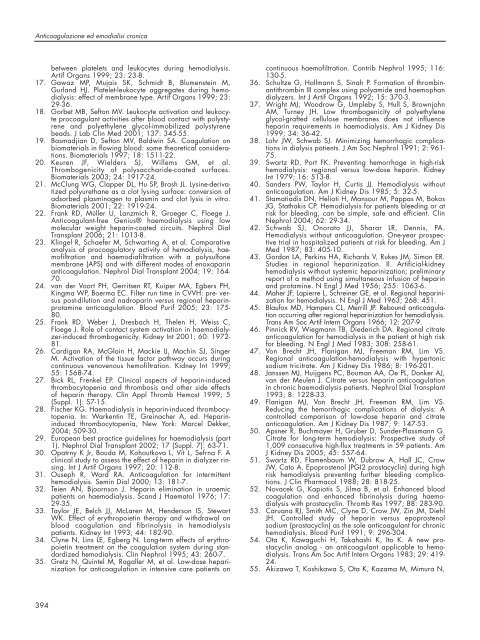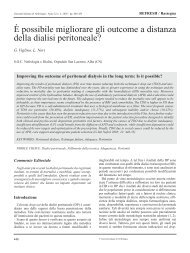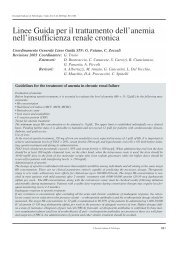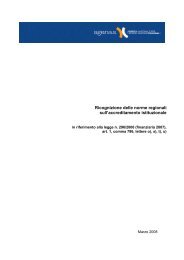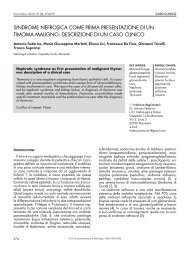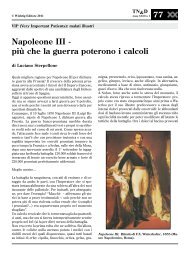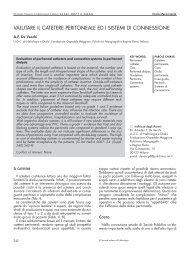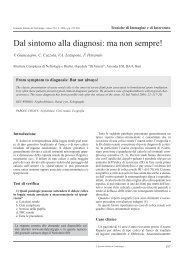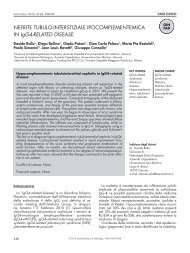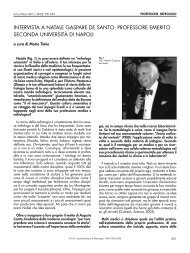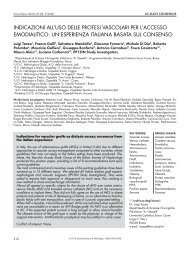Anticoagulazione ed emodialisi cronica - Società Italiana di Nefrologia
Anticoagulazione ed emodialisi cronica - Società Italiana di Nefrologia
Anticoagulazione ed emodialisi cronica - Società Italiana di Nefrologia
Create successful ePaper yourself
Turn your PDF publications into a flip-book with our unique Google optimized e-Paper software.
<strong>Anticoagulazione</strong> <strong>ed</strong> <strong>emo<strong>di</strong>alisi</strong> <strong>cronica</strong><br />
between platelets and leukocytes during hemo<strong>di</strong>alysis.<br />
Artif Organs 1999; 23: 23-8.<br />
17. Gawaz MP, Mujais SK, Schmidt B, Blumenstein M,<br />
Gurland HJ. Platelet-leukocyte aggregates during hemo<strong>di</strong>alysis:<br />
effect of membrane type. Artif Organs 1999; 23:<br />
29-36.<br />
18. Gorbet MB, Sefton MV. Leukocyte activation and leukocyte<br />
procoagulant activities after blood contact with polystyrene<br />
and polyethylene glycol-immobiliz<strong>ed</strong> polystyrene<br />
beads. J Lab Clin M<strong>ed</strong> 2001; 137: 345-55.<br />
19. Basmadjian D, Sefton MV, Baldwin SA. Coagulation on<br />
biomaterials in flowing blood: some theoretical considerations.<br />
Biomaterials 1997; 18: 1511-22.<br />
20. Keuren JF, Wielders SJ, Willems GM, et al.<br />
Thrombogenicity of polysaccharide-coat<strong>ed</strong> surfaces.<br />
Biomaterials 2003; 24: 1917-24.<br />
21. McClung WG, Clapper DL, Hu SP, Brash JL. Lysine-derivatiz<strong>ed</strong><br />
polyurethane as a clot lysing surface: conversion of<br />
adsorb<strong>ed</strong> plasminogen to plasmin and clot lysis in vitro.<br />
Biomaterials 2001; 22: 1919-24.<br />
22. Frank RD, Müller U, Lanzmich R, Groeger C, Floege J.<br />
Anticoagulant-free Genius® haemo<strong>di</strong>alysis using low<br />
molecular weight heparin-coat<strong>ed</strong> circuits. Nephrol Dial<br />
Transplant 2006; 21: 1013-8.<br />
23. Klingel R, Schaefer M, Schwarting A, et al. Comparative<br />
analysis of procoagulatory activity of hemo<strong>di</strong>alysis, haemofiltration<br />
and haemo<strong>di</strong>afiltration with a polysulfone<br />
membrane (APS) and with <strong>di</strong>fferent modes of enoxaparin<br />
anticoagulation. Nephrol Dial Transplant 2004; 19: 164-<br />
70.<br />
24. van der Voort PH, Gerritsen RT, Kuiper MA, Egbers PH,<br />
Kingma WP, Boerma EC. Filter run time in CVVH: pre- versus<br />
post-<strong>di</strong>lution and nadroparin versus regional heparinprotamine<br />
anticoagulation. Blood Purif 2005; 23: 175-<br />
80.<br />
25. Frank RD, Weber J, Dresbach H, Thelen H, Weiss C,<br />
Floege J. Role of contact system activation in haemo<strong>di</strong>alyzer-induc<strong>ed</strong><br />
thrombogenicity. Kidney Int 2001; 60: 1972-<br />
81.<br />
26. Car<strong>di</strong>gan RA, McGloin H, Mackie IJ, Machin SJ, Singer<br />
M. Activation of the tissue factor pathway occurs during<br />
continuous venovenous hemofiltration. Kidney Int 1999;<br />
55: 1568-74.<br />
27. Bick RL, Frenkel EP. Clinical aspects of heparin-induc<strong>ed</strong><br />
thrombocytopenia and thrombosis and other side effects<br />
of heparin therapy. Clin Appl Thromb Hemost 1999; 5<br />
(Suppl. 1): S7-15.<br />
28. Fischer KG. Haemo<strong>di</strong>alysis in heparin-induc<strong>ed</strong> thrombocytopenia.<br />
In: Warkentin TE, Greinacher A, <strong>ed</strong>. Heparininduc<strong>ed</strong><br />
thrombocytopenia, New York: Marcel Dekker,<br />
2004; 509-30.<br />
29. European best practice guidelines for haemo<strong>di</strong>alysis (part<br />
1). Nephrol Dial Transplant 2002; 17 (Suppl. 7): 63-71.<br />
30. Opatrny K Jr, Bouda M, Kohoutkova L, Vit L, Sefrna F. A<br />
clinical study to assess the effect of heparin in <strong>di</strong>alyzer rinsing.<br />
Int J Artif Organs 1997; 20: 112-8.<br />
31. Ouseph R, Ward RA. Anticoagulation for intermittent<br />
hemo<strong>di</strong>alysis. Semin Dial 2000; 13: 181-7.<br />
32. Teien AN, Bjoornson J. Heparin elimination in uraemic<br />
patients on haemo<strong>di</strong>alysis. Scand J Haematol 1976; 17:<br />
29-35.<br />
33. Taylor JE, Belch JJ, McLaren M, Henderson IS, Stewart<br />
WK. Effect of erythropoietin therapy and withdrawal on<br />
blood coagulation and fibrinolysis in hemo<strong>di</strong>alysis<br />
patients. Kidney Int 1993; 44: 182-90.<br />
34. Clyne N, Lins LE, Egberg N. Long-term effects of erythropoietin<br />
treatment on the coagulation system during standar<strong>di</strong>z<strong>ed</strong><br />
hemo<strong>di</strong>alysis. Clin Nephrol 1995; 43: 260-7.<br />
35. Gretz N, Quintel M, Ragaller M, et al. Low-dose heparinization<br />
for anticoagulation in intensive care patients on<br />
394<br />
continuous haemofiltration. Contrib Nephrol 1995; 116:<br />
130-5.<br />
36. Schultze G, Hollmann S, Sinah P. Formation of thrombinantithrombin<br />
III complex using polyamide and haemophan<br />
<strong>di</strong>alyzers. Int J Artif Organs 1992; 15: 370-3.<br />
37. Wright MJ, Woodrow G, Umpleby S, Hull S, Brownjohn<br />
AM, Turney JH. Low thrombogenicity of polyethylene<br />
glycol-graft<strong>ed</strong> cellulose membranes does not influence<br />
heparin requirements in haemo<strong>di</strong>alysis. Am J Kidney Dis<br />
1999; 34: 36-42.<br />
38. Lohr JW, Schwab SJ. Minimizing hemorrhagic complications<br />
in <strong>di</strong>alysis patients. J Am Soc Nephrol 1991; 2: 961-<br />
75.<br />
39. Swartz RD, Port FK. Preventing hemorrhage in high-risk<br />
hemo<strong>di</strong>alysis: regional versus low-dose heparin. Kidney<br />
Int 1979; 16: 513-8.<br />
40. Sanders PW, Taylor H, Curtis JJ. Hemo<strong>di</strong>alysis without<br />
anticoagulation. Am J Kidney Dis 1985; 5: 32-5.<br />
41. Stamatia<strong>di</strong>s DN, Helioti H, Mansour M, Pappas M, Bokos<br />
JG, Stathakis CP. Hemo<strong>di</strong>alysis for patients ble<strong>ed</strong>ing or at<br />
risk for ble<strong>ed</strong>ing, can be simple, safe and efficient. Clin<br />
Nephrol 2004; 62: 29-34.<br />
42. Schwab SJ, Onorato JJ, Sharar LR, Dennis, PA.<br />
Hemo<strong>di</strong>alysis without anticoagulation. One-year prospective<br />
trial in hospitaliz<strong>ed</strong> patients at risk for ble<strong>ed</strong>ing. Am J<br />
M<strong>ed</strong> 1987; 83: 405-10.<br />
43. Gordon LA, Perkins HA, Richards V, Rukes JM, Simon ER.<br />
Stu<strong>di</strong>es in regional heparinization. II. Artificial-kidney<br />
hemo<strong>di</strong>alysis without systemic heparinization; preliminary<br />
report of a method using simultaneous infusion of heparin<br />
and protamine. N Engl J M<strong>ed</strong> 1956; 255: 1063-6.<br />
44. Maher JF, Lapierre L, Schreiner GE, et al. Regional heparinization<br />
for hemo<strong>di</strong>alysis. N Engl J M<strong>ed</strong> 1963; 268: 451.<br />
45. Blaufox MD, Hampers CL, Merrill JP. Rebound anticoagulation<br />
occurring after regional heparinization for hemo<strong>di</strong>alysis.<br />
Trans Am Soc Artif Intern Organs 1966; 12: 207-9.<br />
46. Pinnick RV, Wiegmann TB, Di<strong>ed</strong>erich DA. Regional citrate<br />
anticoagulation for hemo<strong>di</strong>alysis in the patient at high risk<br />
for ble<strong>ed</strong>ing. N Engl J M<strong>ed</strong> 1983; 308: 258-61.<br />
47. Von Brecht JH, Flanigan MJ, Freeman RM, Lim VS.<br />
Regional anticoagulation-hemo<strong>di</strong>alysis with hypertonic<br />
so<strong>di</strong>um tricitrate. Am J Kidney Dis 1986; 8: 196-201.<br />
48. Janssen MJ, Huijgens PC, Bouman AA, Oe PL, Donker AJ,<br />
van der Meulen J. Citrate versus heparin anticoagulation<br />
in chronic haemo<strong>di</strong>alysis patients. Nephrol Dial Transplant<br />
1993; 8: 1228-33.<br />
49. Flanigan MJ, Von Brecht JH, Freeman RM, Lim VS.<br />
R<strong>ed</strong>ucing the hemorrhagic complications of <strong>di</strong>alysis: A<br />
controll<strong>ed</strong> comparison of low-dose heparin and citrate<br />
anticoagulation. Am J Kidney Dis 1987; 9: 147-53.<br />
50. Apsner R, Buchmayer H, Gruber D, Sunder-Plassmann G.<br />
Citrate for long-term hemo<strong>di</strong>alysis: Prospective study of<br />
1,009 consecutive high-flux treatments in 59 patients. Am<br />
J Kidney Dis 2005; 45: 557-64.<br />
51. Swartz RD, Flamenbaum W, Dubrow A, Hall JC, Crow<br />
JW, Cato A. Epoprostenol (PGI2 prostacyclin) during high<br />
risk hemo<strong>di</strong>alysis preventing further ble<strong>ed</strong>ing complications.<br />
J Clin Pharmacol 1988; 28: 818-25.<br />
52. Novacek G, Kapiotis S, Jilma B, et al. Enhanc<strong>ed</strong> blood<br />
coagulation and enhanc<strong>ed</strong> fibrinolysis during haemo<strong>di</strong>alysis<br />
with prostacyclin. Thromb Res 1997; 88: 283-90.<br />
53. Caruana RJ, Smith MC, Clyne D, Crow JW, Zin JM, Diehl<br />
JH. Controll<strong>ed</strong> study of heparin versus epoprostenol<br />
so<strong>di</strong>um (prostacyclin) as the sole anticoagulant for chronic<br />
hemo<strong>di</strong>alysis. Blood Purif 1991; 9: 296-304.<br />
54. Ota K, Kawaguchi H, Takahashi K, Ito K. A new prostacyclin<br />
analog - an anticoagulant applicable to hemo<strong>di</strong>alysis.<br />
Trans Am Soc Artif Intern Organs 1983; 29: 419-<br />
24.<br />
55. Akizawa T, Koshikawa S, Ota K, Kazama M, Mimura N,


